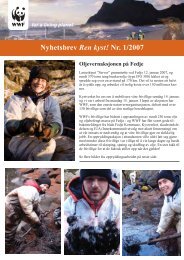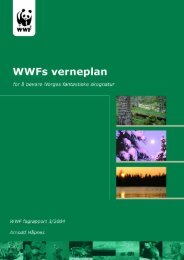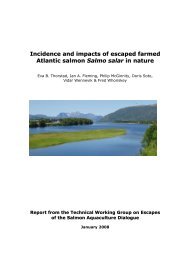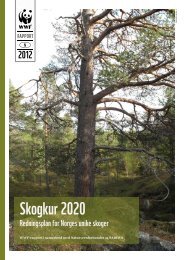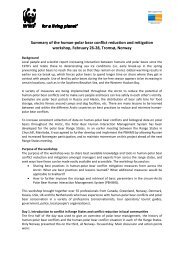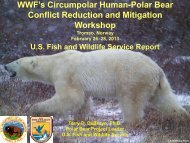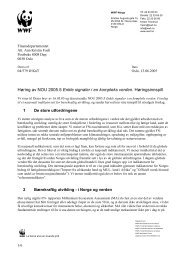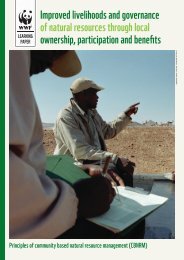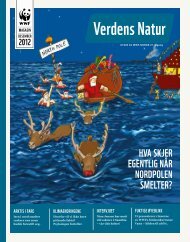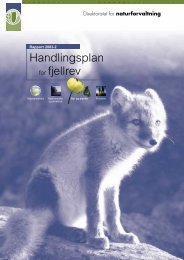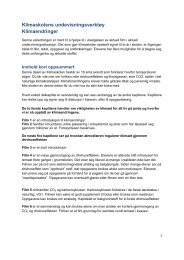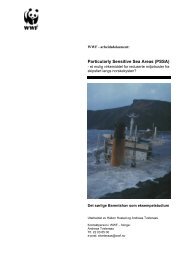REDD+ AT A CROSSROADS: - WWF
REDD+ AT A CROSSROADS: - WWF
REDD+ AT A CROSSROADS: - WWF
Create successful ePaper yourself
Turn your PDF publications into a flip-book with our unique Google optimized e-Paper software.
<strong>WWF</strong> expectations for <strong>REDD+</strong> in Durban<strong>WWF</strong> is calling for an agreement in Durban that includes the following key principles:Funding to support results-based actions should come from a flexiblecombination of public and private sources, including market based sources, as wellas scaled up bilateral and multilateral sources. As agreed in Cancun, funding for otheractions should be limited to existing or new sources of public finance.Durban should look into new and innovative sources, beyond existing publicfinance sources, including <strong>REDD+</strong> finance coming from innovative climate adaptationand mitigation financing mechanisms such as forest climate bonds 1 , measures toaddress emissions from international aviation and shipping 2 , or financial transactiontaxes.<strong>REDD+</strong> credits should only be included within compliance market-basedmechanisms during Phase 3 if they represent performance-based results that are:• Quantified against a national reference emissions level/forest reference level or asub-national reference emissions level/forest reference level that is incorporatedinto a national accounting system; and• Fully monitored, reported, and verified at the national level in a manner thataccounts for emissions leakage or displacement.As a finance source, offsetting in compliance markets should meet the followingconditions:• It is additional, preserves market integrity, and avoids double-counting;• Limited to <strong>REDD+</strong> countries that have reached phase 3;• Developed countries commit to a 40% emissions reduction by 2020 as compared to1990 levels, with the vast majority achieved domestically through transformingcritical sectors such as energy.Given the gigatonne gap that currently exists to meet the 2°C goal from the CancunAgreements, <strong>REDD+</strong> Finance should primarily be used to achieve additionalreductions in emissions above and beyond national commitments, rather than usedas an offset mechanism for donor countries to meet their own domestic commitments.Agree to a Green Climate Fund in Durban and, following the recommendations of theTransitional Committee by its fourth meeting to COP 17, agree to add a dedicated<strong>REDD+</strong> window under the GCF by the 1 st meeting of the board of the GCF to secure aflow of new, additional, predictable and adequate finance for <strong>REDD+</strong>.B) Scaled up funding for phase 1 and 2 urgently neededDeveloping countries must be assisted in their efforts to achieve the pre-conditionsnecessary for the full implementation (phase 3) of <strong>REDD+</strong>.Scaled up funding from bilateral and multilateral sources is urgently needed toassist developing countries in achieving the full implementation phase of <strong>REDD+</strong> andachieving the pre-conditions necessary for results-based performance.1 Cranford, M., Henderson ,I.R., Mitchell, A.W., Kidney, S. and Kanak, D.P., “Unlocking Forest Bonds – A High-Level Workshopon Innovative Finance for Tropical Forests”, Workshop Report. <strong>WWF</strong> Forest & Climate Initiative, Global Canopy Programme andClimate Bonds Initiative.http://wwf.panda.org/what_we_do/footprint/climate_carbon_energy/forest_climate/publications/?201251/Unlocking-forest-bonds2 “International Transport: Turning an Emission Problem into a Finance Opportunity”, <strong>WWF</strong> Recommendation Paper, June 2011http://wwf.panda.org/about_our_earth/aboutcc/publications/?uNewsID=200520Page 2 of 4
<strong>WWF</strong> expectations for <strong>REDD+</strong> in DurbanC) Estimate global <strong>REDD+</strong> finance needs from the “bottom up”Most available figures on <strong>REDD+</strong> implementation are “top-down” estimates based oninternational analyses using generic scenarios that have not been validated withinimplementing country realities. More realistic national estimates are needed. These shouldbe based on approaches from the bottom-up (local and regional) implementation withsubnational (i.e. local and regional) costs associated with clear actions, targets andtimescales.Durban should start a process under the UNFCCC to develop a commonmethodology and set of assumptions to derive these “bottom-up” estimates.2. Decide on <strong>REDD+</strong> methodologies that benefit the climate,people and natureA) Maximise <strong>REDD+</strong> co-benefits for people and nature (Safeguards)In Durban, Parties should agree on a common framework for nationalinformation systems on safeguards, guided by a harmonized international structurethat includes measurable indicators, guarantees transparency and full and effectivestakeholder participation, and allows comparisons to be made between nationalsystems.B) Avoid “hot air” and reward countries equitably (RL/REL)In Durban, Parties should agree on modalities for setting reference levels / referenceemission levels aligned with principles that ensure additionality, avoiddisplacement, leakage and double-counting, are based on historic data, and provideincentives for countries with low deforestation rates to conserve existing forest carbonstocks.C) Measuring, Monitoring, Reporting and Verifying of <strong>REDD+</strong> (MRV):Start “simple” and aim for continuous improvementThe Cancun COP16 Decision requests that developing country Parties develop robust andtransparent national forest information management systems for monitoring andreporting (but not verifying) <strong>REDD+</strong> activities. The Decision further requested the SBSTAto develop modalities for MRV of anthropogenic forest-related emissions.MRV is a complex issue and there is no one single data source that can cover all <strong>REDD+</strong>data needs. Therefore, an optimal combination of data sources needs to be found, takinginto consideration cost, data quality and potential results of <strong>REDD+</strong> activities.National MRV systems should build upon existing data and expertise, and shouldaim for continuous improvement. MRV of <strong>REDD+</strong> should use the most recentIPCC guidelines using lessons learned from “fast start” experiences such as theGuyana - Norway agreement.In Durban, Parties should agree on using MRV as an instrument to generatecredibility and public trust, such that <strong>REDD+</strong> demonstrably contributes to:• Significant and permanent greenhouse gas emission reductions• Addressing the underlying causes of deforestation and forest degradation• Maintaining and/or enhancing biodiversity and ecosystem services• Sustainable and equitable livelihoods• Recognizing and respecting the rights of indigenous peoples and localcommunities• Full and effective participation of indigenous peoples and local communitiesPage 3 of 4
<strong>WWF</strong> expectations for <strong>REDD+</strong> in Durban3. Adopt a global <strong>REDD+</strong> mitigation target linked to long-termfinanceWhile Parties in Cancun at COP16 agreed that countries should aim to slow, halt andreverse forest cover and carbon loss, no date was agreed by which this should be achieved.A clear, ambitious and measurable global target for reduced emissions from deforestationand forest degradation is a critical milestone toward limiting global climate change to wellbelow a 2°C average increase.A global <strong>REDD+</strong> target would also set the benchmark for an associated global target forassociated financing to ensure that adequate resources are available to implement <strong>REDD+</strong>at scale. Such a target is needed to avoid dangerous climate change, to reverse thealarming trend of biodiversity loss, and to ensure socio-environmental benefits for themore than 1.2 billion people on Earth who depend upon forests for their livelihoods.The Living Forest Report, Chapter 3, demonstrates that while <strong>WWF</strong>’s proposed target ofZero Net Deforestation and Forest Degradation (ZNDD) by 2020 is technicallyfeasible, it is only realistic if we employ a <strong>REDD+</strong> regime at scale. ZNDD by 2020 will alsoresult in zero net emissions from forest loss and degradation by 2020.In Durban, Parties should agree to set a measurable, time-bound, global <strong>REDD+</strong>target by COP18.4. Address drivers of deforestationIn order for <strong>REDD+</strong> to succeed, it must effectively reduce, and ultimately reverse, thedrivers of deforestation. Doing this involves reforming ineffective legal and governanceframeworks, harmonizing land use policies across different sectors (e.g. agricultural,mining, public infrastructure and forests), reducing the negative footprint of national andinternational markets and trade, removing perverse subsidies that result in forest clearing,and clarifying land use rights and responsibilities.While the Cancun COP16 Agreement recognised the need for all countries to reducepressure on forests and to address the drivers of deforestation, how this will be achievedremains undefined.In Durban, Parties should agree on a specific process (including a work plan) todevelop methodologies to address the drivers of deforestation in time for adoptionby COP18, and agree for countries to report back on progress by COP19.For further information:Bruce CabarleLeader, <strong>WWF</strong> Forest & Climate InitiativeBruce.Cabarle@wwfus.orgGerald SteindleggerPolicy Director, <strong>WWF</strong> Forest & Climate Initiativegerald.steindlegger@wwf.atMelissa TupperCommunications Director, <strong>WWF</strong> Forest & Climate InitiativeMelissa.Tupper@wwfus.orgPage 4 of 4




